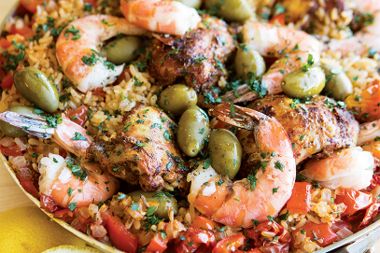
This vibrant Spanish-inspired casserole is sure to get a rousing olé from around the dinner table. To round out the meal, serve with a leafy green salad dressed in a simple lemon juice and olive oil vinaigrette.
Make ahead
This casserole is best eaten the day it’s made. However, to assemble this casserole in minutes, softened tomatoes, red pepper, flavourings, and stock can be mixed together and refrigerated for up to 2 days. Chicken may also be marinated and refrigerated for up to 1 day. When ready to bake, add rice and tomato mixture, bringing to a boil before adding chicken and baking as directed in the recipe.
Queen of spices
Saffron is actually the stigmas produced by a species of crocus flower. Each flower only produces three stigmas, which are picked by hand at dawn, before the flower opens, in order to preserve its aroma and flavour properties. The stigmas are dried to create saffron.
Sustainable catch
Read the label when buying seafood, especially shrimp. Look for wild, or sustainably farmed or harvested options. Ask your fishmonger or opt for wild-caught shrimp from North America and avoid imported shrimp, which may not be held to the same environmental standards.
Baked Paella
Ingredients
- 1 tsp (5 mL) dried oregano
- 1 1/2 tsp (7 mL) smoked sweet paprika
- Pinch hot dried chili flakes (optional)
- 1/2 tsp (2 mL) salt
- 1/4 tsp (1 mL) ground black pepper
- 6 skinless, boneless organic chicken thighs
- 2 Tbsp (30 mL) grapeseed oil
- 2 cups (500 mL) cherry tomatoes
- 1 small red onion, finely chopped
- 2 garlic cloves, minced
- 1 1/2 cups (350 mL) whole grain parboiled brown rice
- 1 red pepper, chopped
- Pinch saffron strands (optional)
- 1 tsp (5 mL) chopped fresh rosemary
- 3 cups (750 mL) low-sodium vegetable stock or chicken stock
- 12 large raw prawns, deveined but shell left on
- 1/2 cup (125 mL) pitted green olives
- 2 Tbsp (30 mL) chopped fresh parsley, for garnish
- 1 lemon, cut into wedges
Nutrition
Per serving:
- calories353
- protein21g
- fat10g
- saturated fat2g
- trans fat0g
- carbohydrates44g
- sugars3g
- fibre4g
- sodium433mg
Directions
01
Preheat oven to 425 F (220 C).
02
In medium bowl, whisk together oregano, paprika, chili flakes (if using), salt, and pepper. Add chicken and coat in spice mixture. Refrigerate, allowing chicken to marinate for 10 minutes.
03
Meanwhile, warm oil in 3 1/2 quart (3.3 L) Dutch oven over medium heat. Add tomatoes, onion, and garlic. Cover and cook for about 10 minutes, stirring occasionally until tomatoes burst. Stir in rice, red pepper, saffron (if using), rosemary, and stock. Increase heat to high and bring mixture to a boil. Nestle marinated chicken into rice mixture before covering and placing in oven for 10 minutes.
04
Stir in prawns and green olives before returning covered casserole once again to oven for a further 10 to 15 minutes, or until rice is tender and chicken and shrimp are cooked through. Garnish with parsley and serve lemon wedges alongside.





